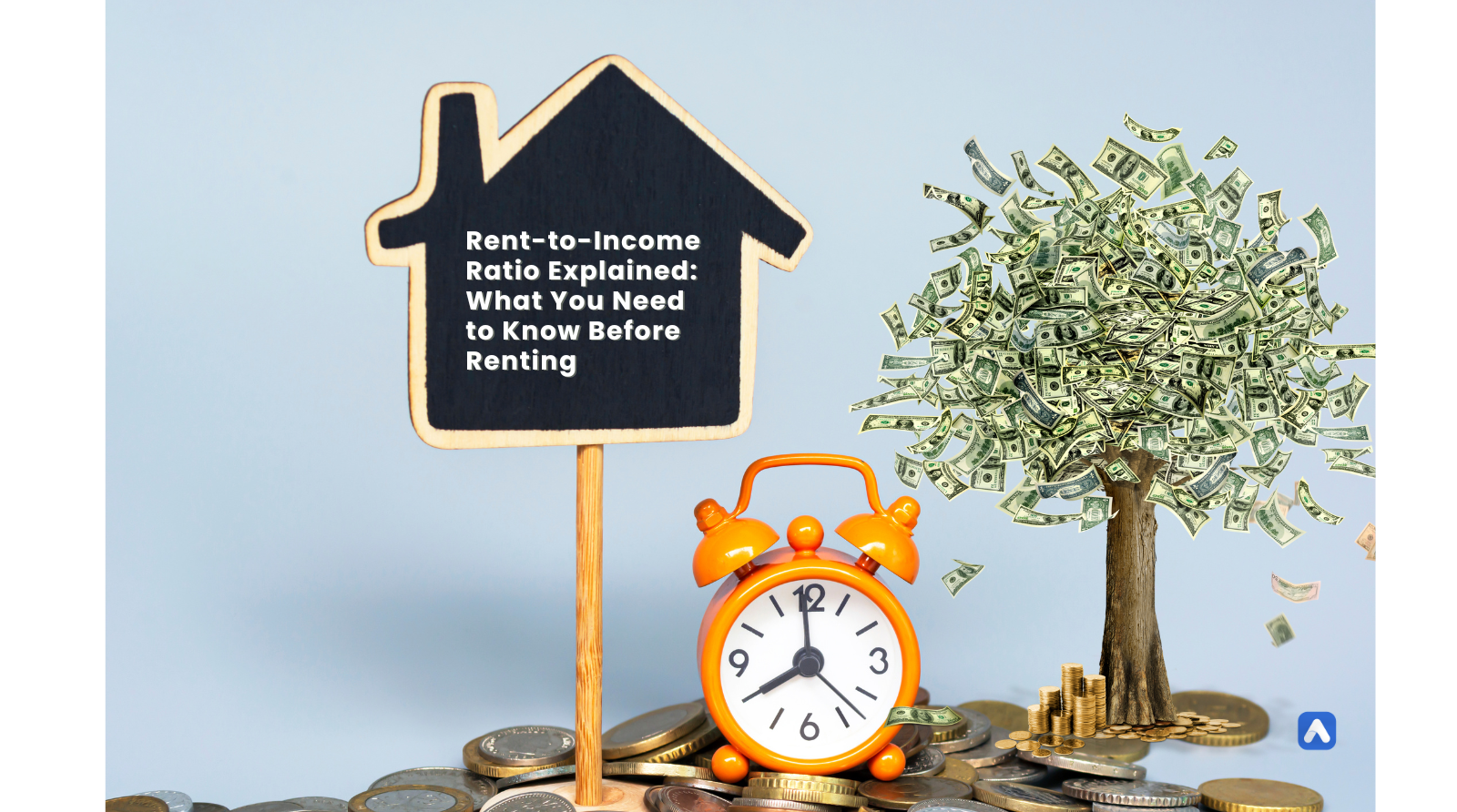Rent-to-Income Ratio Explained: What You Need to Know Before Renting
The Rent-to-Income Ratio: A Financial Guide
The rent-to-income ratio is a fundamental metric in housing finance, measuring the percentage of a person’s income allocated to rent. It serves as a crucial benchmark for both tenants and landlords.
Definition: The rent-to-income ratio is calculated by dividing monthly rent by gross monthly income. For example, a $1,200 monthly rent on a $4,000 salary equates to a 30% ratio.
Importance:
- Tenants: A high ratio can strain finances, limiting spending on other essentials. Generally, a ratio below 30% is considered ideal, providing financial flexibility and improving creditworthiness.
- Landlords: A low tenant ratio indicates financial stability, reducing the risk of missed rent and potential evictions.
The 30% Rule: A widely accepted guideline, the 30% rule suggests housing costs (rent, utilities, HOA fees) should not exceed 30% of income. It originated as a general financial planning principle and has been adopted by many lenders and financial experts.
Factors Affecting the Ratio:

Implications of Exceeding the 30% Rule:
- Financial Stress: A high ratio can lead to difficulties meeting other financial obligations.
- Reduced Creditworthiness: Lenders often consider debt-to-income ratios, and a high rent-to-income ratio can negatively impact credit scores.
- Increased Risk of Default: A strained financial situation increases the likelihood of missed rent payments and potential eviction.
Strategies for Managing the Ratio:
- Budgeting: Carefully track income and expenses to identify areas for savings.
- Roommates: Consider sharing housing to reduce individual rent costs.
- Relocation: If possible, explore more affordable areas with lower housing costs.
- Negotiation: In some cases, landlords may be open to negotiating rent.
The History and Development of Rent-to-Income Ratio
The concept of a rent-to-income ratio as a measure of housing affordability has evolved over time, influenced by economic conditions, social trends, and government policies.
Early Historical Context
While the term “rent-to-income ratio” is a relatively modern one, the underlying concept of measuring housing affordability based on income has existed for centuries. In ancient civilizations, housing affordability was often tied to social status and economic standing. For example, in medieval Europe, the concept of a “just price” for housing was often based on the ability of a household to afford it without undue financial hardship.
The Industrial Revolution and Urbanization
The Industrial Revolution and subsequent urbanization significantly impacted housing affordability. As people migrated to cities in search of work, demand for housing increased, driving up prices. This led to the emergence of tenement housing, often characterized by overcrowding, poor living conditions, and high rents.
The Great Depression and New Deal Policies
The Great Depression, a period of severe economic hardship, highlighted the importance of affordable housing. The New Deal policies implemented by the U.S. government, such as the Public Works Administration (PWA) and the Federal Housing Administration (FHA), aimed to address housing affordability by providing government-backed loans and subsidies. These policies helped to create a more stable housing market and improve access to affordable housing for many Americans.
Post-World War II and the Suburban Boom
Following World War II, the United States experienced a significant population boom and a shift towards suburban living. This led to a surge in demand for single-family homes, which were often more affordable than urban housing options. Government policies, such as the GI Bill, provided veterans with low-interest loans to purchase homes, further fueling the suburban boom.
The Rise of the 30% Rule
The 30% rule, which suggests that housing costs should not exceed 30% of income, emerged as a popular guideline in the mid-20th century. This rule likely originated from financial experts and housing counselors who observed that excessive housing costs could strain household budgets and lead to financial difficulties. The 30% rule became a widely accepted benchmark for assessing housing affordability and is still used today.
Modern Developments and Challenges
In recent decades, housing affordability has become a growing concern in many parts of the world. Rising housing prices, coupled with stagnant wages, have made it increasingly difficult for many people to afford a place to live. This has led to a renewed focus on affordable housing policies and initiatives.
Additionally, the increasing popularity of rental housing, particularly among younger generations, has highlighted the importance of rent-to-income ratios as a measure of affordability for renters. Factors such as student loan debt, rising healthcare costs, and the gig economy have also contributed to the challenges of achieving a sustainable rent-to-income ratio.
The concept of a rent-to-income ratio has a long and complex history. While the 30% rule remains a widely accepted benchmark, it’s important to recognize that individual circumstances and economic conditions can vary, and there may be instances where a higher or lower ratio is appropriate. As housing affordability continues to be a pressing issue, it is likely that the concept of the rent-to-income ratio will remain a central focus in discussions about housing policy and financial planning.
Calculating Rent-to-Income Ratio
Understanding the Formula
The rent-to-income ratio is a straightforward calculation that helps assess housing affordability. It is determined by dividing your monthly rent by your gross monthly income:
- Rent-to-Income Ratio = Monthly Rent / Gross Monthly Income
Gross Income vs. Net Income: A Crucial Distinction
When calculating the rent-to-income ratio, it’s essential to use your gross monthly income, which is your total income before taxes and deductions. This provides a more accurate representation of your overall financial capacity. Using net income (income after taxes and deductions) can understate your ability to afford housing.
Practical Examples
- Example 1: If you earn $4,500 per month and pay $1,350 in rent, your rent-to-income ratio is 30% (1,350 / 4,500).
- Example 2: If you earn $3,200 per month and pay $850 in rent, your rent-to-income ratio is 26.6% (850 / 3,200).
Rent-to-Income Ratios for Different Property Types
The ideal rent-to-income ratio can vary depending on the type of property:

Factors Affecting Rent-to-Income Ratio
Several factors can influence the appropriate rent-to-income ratio for an individual:
- Other Debt Obligations: Credit card debt, student loans, and car loans can reduce the amount of income available for rent.
- Savings Goals: If you are saving for a down payment on a home or other major purchases, you may want to keep your rent-to-income ratio lower.
- Lifestyle Factors: Your lifestyle and spending habits can also impact your ability to afford rent. For example, if you have a high-cost lifestyle, you may need a lower rent-to-income ratio.
- Geographic Location: Housing costs can vary significantly depending on your location. In high-cost areas, it may be more challenging to maintain a low rent-to-income ratio.
Understanding the 30% Rule: A Closer Look
The 30% Rule: A Foundation for Housing Affordability
The 30% rule, a widely accepted financial guideline, suggests that housing costs, including rent, utilities, and homeowners association fees, should not exceed 30% of your gross monthly income. This rule provides a benchmark for determining affordable housing, ensuring that you have sufficient funds for other essential expenses and financial goals.
Pros and Cons of Adhering to the 30% Rule
Pros
- Financial Stability: Limiting housing costs to 30% of your income helps maintain financial stability and reduces financial stress.
- Improved Creditworthiness: A lower rent-to-income ratio can positively impact your credit score, as lenders consider this metric.
- Flexibility: Following the 30% rule allows more financial flexibility, helping you save for future goals like homeownership or retirement.
Cons
- Geographic Variations: Housing costs vary by location. In high-cost areas, adhering to the 30% rule may require lifestyle sacrifices.
- Individual Circumstances: The rule may not work for everyone. Factors like debt, savings goals, and lifestyle affect the appropriate rent-to-income ratio.
- Economic Fluctuations: Economic downturns can impact housing affordability, making it difficult to maintain a low rent-to-income ratio.
Is the 30% Rule Still Relevant in Today’s Market?
Despite rising housing costs in many areas, the 30% rule remains a valuable guideline for determining affordable housing. However, it’s essential to consider individual circumstances and local market conditions when applying this rule.
Variations in the 30% Rule by Location, Income Level, and Lifestyle
- Geographic Variations: Housing costs can vary significantly by location. In high-cost areas like New York City or San Francisco, it may be difficult to adhere to the 30% rule without making significant sacrifices in lifestyle.
- Income Level: Higher-income earners may be able to afford a higher rent-to-income ratio, while lower-income earners may need to adhere more strictly to the 30% rule.
- Lifestyle: Individual lifestyles and spending habits can also influence the appropriate rent-to-income ratio. For example, individuals with a high-cost lifestyle may need to keep their rent-to-income ratio lower to avoid financial strain.
While the 30% rule provides a useful benchmark for housing affordability, it’s important to consider individual circumstances and local market conditions when making housing decisions. By understanding the benefits and limitations of the 30% rule, you can make informed choices that align with your financial goals and lifestyle.
Rent-to-Income Ratio and Housing Affordability
The Impact of Rent-to-Income Ratio on Housing Choices
The rent-to-income ratio, a fundamental metric in housing finance, significantly influences housing choices. A high ratio, typically exceeding 30%, can strain finances, limiting spending on other essentials and reducing financial flexibility. Conversely, a lower ratio provides more financial security and can improve creditworthiness.
When considering housing options, individuals should carefully evaluate their rent-to-income ratio to ensure it aligns with their financial goals and lifestyle. A higher ratio may necessitate sacrifices in other areas of the budget, such as savings or discretionary spending. Conversely, a lower ratio can provide more financial freedom and peace of mind.
The Role of Location and Regional Cost of Living
Geographic location plays a pivotal role in housing affordability. In high-cost areas, such as major metropolitan centers,rent-to-income ratios tend to be higher due to increased demand and limited housing supply. Conversely, in more affordable regions, individuals may be able to secure housing with lower rent-to-income ratios.
Understanding the regional cost of living is essential when evaluating housing options. Individuals should research average rental prices, utility costs, and other expenses in their desired location to determine a realistic rent-to-income ratio.
Balancing Rent Payments with Other Living Expenses
While the rent-to-income ratio is a crucial metric, it’s essential to consider other living expenses when assessing housing affordability. Utilities, groceries, healthcare, transportation, and other costs can significantly impact overall household budgets.
Creating a comprehensive budget that includes all monthly expenses, including housing costs, is essential. This will help individuals determine whether their rent-to-income ratio is sustainable and if they can afford other essential expenses. A well-balanced budget ensures that housing costs do not strain finances and allow for adequate funds for other needs.
Rent Burden and Cost-Burdened Households
- Rent Burden: A household is considered rent-burdened if it spends more than 30% of its income on rent.
- Cost-Burdened Household: This term refers to households that spend more than 30% of their income on housing costs, including rent, utilities, and homeowners association fees.
Being rent-burdened or cost-burdened can significantly strain household finances, making it difficult to save for future goals, meet financial obligations, and maintain financial stability. It can also increase the risk of financial hardship and eviction.
Individuals should strive to maintain a rent-to-income ratio below 30% to avoid becoming rent-burdened. However, in some cases, it may be necessary to exceed this threshold, particularly in high-cost areas. In such instances, it’s essential to carefully consider other financial obligations and ensure that housing costs do not compromise overall financial well-being.
Rent-to-Income Ratio for Tenants: A Deeper Dive
Understanding Your Rent-to-Income Ratio
The rent-to-income ratio is a crucial metric for tenants, as it helps assess the affordability of your housing costs. By calculating your ratio, you can determine whether your current rent is sustainable and if you have sufficient funds for other essential expenses.
Signs You May Be Paying Too Much for Rent
- Financial Strain: If you consistently struggle to meet your monthly financial obligations, such as paying bills or saving for future goals, it may be a sign that your rent is too high.
- Limited Savings: Difficulty saving for emergencies or future goals can also indicate that your rent-to-income ratio is excessive.
- Reduced Quality of Life: If you find yourself constantly cutting back on essential expenses or sacrificing your lifestyle to afford rent, it’s a clear indicator that your housing costs are too high.
Strategies for Reducing Housing Costs and Improving Your Rent-to-Income Ratio
- Consider Roommates: Sharing housing with roommates can significantly reduce your monthly rent costs.
- Relocation: If you’re in a high-cost area, consider relocating to a more affordable location.
- Negotiate Rent: In some cases, landlords may be open to negotiating rent, especially if you have a long-term rental history or can offer to make improvements to the property.
- Reduce Utilities: Conserving energy and water can help lower your utility bills, reducing your overall housing costs.
- Explore Government Assistance Programs: There may be government assistance programs available to help you reduce your housing costs, such as rental assistance or Section 8 housing vouchers.
Financial Health Indicators Beyond Rent-to-Income Ratio
While the rent-to-income ratio is a valuable metric, it’s essential to consider other financial health indicators to get a comprehensive picture of your financial situation. These include:
- Debt-to-Income Ratio: This ratio measures your total debt payments compared to your income. A high debt-to-income ratio can strain your finances and make it difficult to afford housing.
- Emergency Fund: Having an emergency fund can provide financial security and help you avoid relying on credit cards or loans in case of unexpected expenses.
- Credit Score: A good credit score can improve your financial health and make it easier to obtain loans or credit.
By understanding your rent-to-income ratio and other financial health indicators, you can make informed decisions about your housing choices and improve your overall financial well-being.
Rent-to-Income Ratio for Landlords and Property Managers
The Importance of Rent-to-Income Ratio in Tenant Screening
Landlords and property managers use the rent-to-income ratio as a key factor in tenant screening. A low ratio indicates that a tenant has a stable financial situation and is more likely to be able to afford the rent. This helps landlords mitigate the risk of rental defaults and evictions, which can be costly and time-consuming.
Rent-to-Income Requirements in Lease Agreements
Many lease agreements include specific rent-to-income requirements. These requirements specify the minimum income a tenant must have to qualify for the rental property. While the specific requirements can vary depending on the landlord or property management company, a common requirement is a rent-to-income ratio of 30% or 40%.
Understanding Risk Management: How Rent-to-Income Ratio Helps Mitigate Evictions
A low rent-to-income ratio can significantly reduce the risk of evictions. By ensuring that tenants have the financial means to afford the rent, landlords can minimize the likelihood of rental defaults and the associated costs of eviction. Evictions can be time-consuming, expensive, and damage a landlord’s reputation.
Flexibility in Rent-to-Income Standards: Assessing Other Financial Criteria
While the rent-to-income ratio is an important factor, it’s not the only criterion landlords consider when screening tenants. Other financial factors that may be taken into account include:
- Savings: A tenant with a substantial savings account may be considered a more reliable tenant, even if their rent-to-income ratio is slightly higher. Savings can provide a financial cushion in case of unexpected expenses or job loss.
- Debt-to-Income Ratio: This ratio measures a tenant’s total debt payments compared to their income. A low debt-to-income ratio indicates that a tenant has a stable financial situation and is less likely to default on rent.
- Credit Score: A good credit score can be an indicator of financial responsibility and can help landlords assess a tenant’s risk profile.
Rent-to-Income Ratio and Debt-to-Income Ratio
Understanding the Differences
- Rent-to-Income Ratio: This ratio measures the percentage of a person’s income that is spent on rent. It directly reflects housing affordability.
- Debt-to-Income Ratio: This ratio measures a person’s total debt payments compared to their income. It provides a broader picture of financial health, considering all debt obligations.
The Importance of Both Ratios for Tenants and Landlords
- For Tenants: Both ratios are crucial for financial planning. A low rent-to-income ratio ensures affordable housing, while a low debt-to-income ratio indicates financial stability and improves creditworthiness.
- For Landlords: Understanding both ratios helps landlords assess a tenant’s financial risk and make informed decisions about tenant selection. A low rent-to-income ratio combined with a low debt-to-income ratio suggests a financially stable tenant.
Gaining a Comprehensive Financial Picture
By considering both ratios, landlords and tenants can gain a more comprehensive understanding of a person’s financial health. A low rent-to-income ratio may indicate affordability, but a high debt-to-income ratio could suggest financial strain. Conversely, a high rent-to-income ratio combined with a low debt-to-income ratio could indicate that a person is stretching their finances to afford housing.
Exceptions to the 30% Rule
High-Income Earners
While the 30% rule is a general guideline, it may not be applicable to all individuals. High-income earners may be able to afford a higher rent-to-income ratio without experiencing financial strain. However, it’s essential to consider individual circumstances and financial goals when determining an appropriate ratio.
Low-Income Households
For low-income households, the 30% rule can be challenging to meet, especially in high-cost areas. In such cases, government assistance programs or other strategies may be necessary to help individuals afford housing.
Understanding Situations Where Higher or Lower Rent-to-Income Ratios May Be Acceptable
- Students: Due to limited income and other expenses, students may need to have a higher rent-to-income ratio.
- Short-Term Renters: Individuals renting for a short period may be willing to accept a higher ratio for a desirable location or property.
- Co-Habitation: Sharing housing with roommates or family members can reduce individual rent-to-income ratios.
- Unique Circumstances: Factors like job relocation, unexpected expenses, or recent job changes can influence the acceptability of a higher or lower ratio.
Additional Considerations for High-Income Earners
- Lifestyle: High-income earners may have higher lifestyle expenses, which can impact their ability to afford housing.
- Savings Goals: Individuals with aggressive savings goals may want to maintain a lower rent-to-income ratio to allocate more funds towards savings.
- Investment Goals: High-income earners may have investment goals that require a significant portion of their income. In such cases, a lower rent-to-income ratio may be necessary.
Additional Considerations for Low-Income Households
- Government Assistance: Low-income households may be eligible for government assistance programs, such as Section 8 housing vouchers or rental assistance.
- Affordable Housing: There may be affordable housing options available, such as public housing or subsidized housing.
- Negotiation: Low-income households may be able to negotiate lower rents with landlords.
Rent-to-Income Ratio and Rental Assistance Programs
The Role of Rent-to-Income Ratio in Housing Assistance Eligibility
The rent-to-income ratio is a critical factor in determining eligibility for many rental assistance programs. These programs often have income limits that are based on a percentage of the area median income (AMI). If your rent-to-income ratio exceeds the program’s income limits, you may not be eligible for assistance.
Understanding Government Programs and Subsidies
- Section 8 Housing Choice Voucher Program: This program provides vouchers that can be used to rent privately owned housing. The voucher amount is based on the fair market rent for the area and the family’s income.
- Public Housing: Public housing units are owned and operated by public housing agencies. These units are typically reserved for low-income families.
- Low-Income Housing Tax Credits: These credits provide tax incentives to developers who build affordable housing units.
Rent-to-Income Calculations for Affordable Housing Projects
Affordable housing projects often have income limits that are based on a percentage of the area median income. To determine your eligibility for affordable housing, you will need to calculate your rent-to-income ratio. This ratio is calculated by dividing your monthly rent by your gross monthly income.
Using Rent-to-Income Ratio in Rental Assistance Program Applications
When applying for rental assistance programs, you will typically be required to provide proof of income. This may include pay stubs, tax returns, or other documentation. Your rent-to-income ratio will be calculated to determine your eligibility for assistance.
Additional Considerations
- Family Size: The number of people in your household can affect your eligibility for rental assistance programs.Larger families may have higher income limits.
- Disability: Individuals with disabilities may be eligible for additional assistance, such as Section 8 Project-Based Voucher programs.
- Other Income Sources: Additional income sources, such as child support or disability payments, may be included in your income calculation.
Navigating the Rental Assistance Process
- Research Local Programs: Identify the rental assistance programs available in your area and understand their specific requirements.
- Gather Required Documentation: Prepare the necessary documentation, such as proof of income, identification, and rental history.
- Complete the Application Process: Submit your application and any required documentation to the appropriate agency.
- Be Patient: The application process can take time, so be patient and follow up if necessary.
For those who cannot be qualify but still need assistance to pay rent, refer to axcessfoundation.org, a partner organization of AxcessRent to receive emergency funding at affordable rate and terms to meet your essential needs.
Rent-to-Income Ratio in Different Housing Markets
Understanding Regional Variations
The rent-to-income ratio can vary significantly across different regions and cities. In high-cost areas, such as major metropolitan centers, rent-to-income ratios tend to be higher due to increased demand for housing and limited supply. Conversely, in more affordable regions, such as rural areas or smaller cities, rent-to-income ratios are typically lower.
The Affordability Crisis in High-Rent Areas
Many major cities are facing an affordability crisis, with rising housing costs making it increasingly difficult for residents to meet the 30% benchmark. This can lead to financial strain, reduced quality of life, and increased risk of eviction.
To address the affordability crisis, policymakers and housing advocates are exploring various solutions, including:
- Increased Investment in Affordable Housing: Building and preserving affordable housing units can help increase the supply of affordable housing options.
- Rent Control Measures: Implementing rent control can help limit rent increases and make housing more affordable.
- Subsidies for Low-Income Renters: Providing subsidies to low-income renters can help them afford housing.
Case Studies: Comparing Urban and Rural Areas
- Urban Areas: In major cities like San Francisco and New York City, rent-to-income ratios can often exceed 30%, making it difficult for many residents to afford housing. This is due to a combination of factors, including high demand for housing, limited supply, and rising property values.
- Rural Areas: In rural areas, rent-to-income ratios are typically lower, making it easier for residents to afford housing. However, other factors, such as job opportunities and access to services, can also influence the overall affordability of living in rural areas.
Trends in Rent-to-Income Ratios for Renters in Expensive Markets
In recent years, rent-to-income ratios have been on the rise in many expensive markets. This trend is driven by several factors, including:
- Increased Demand for Housing: Population growth and economic expansion can increase demand for housing, driving up prices.
- Limited Supply: A shortage of housing units, particularly affordable housing, can also contribute to rising rents.
- Rising Property Values: As property values increase, landlords may raise rents to reflect the increased value of their property.
These factors have combined to make it increasingly difficult for renters in expensive markets to afford housing. As a result, many renters are facing financial strain and may be forced to make sacrifices in other areas of their budget.
Impact of Rent-to-Income Ratio on Long-Term Financial Health
The Interplay Between Housing Costs and Financial Stability
A high rent-to-income ratio can have a profound impact on your long-term financial health. When a significant portion of your income is dedicated to housing costs, it can limit your ability to save, manage debt, and invest. This can hinder your progress towards financial goals, such as saving for a down payment on a home, retirement, or education.
The Ripple Effects of High Housing Costs
- Limited Savings: A high rent-to-income ratio can make it difficult to save for emergencies, retirement, or other financial goals. This can leave you vulnerable to financial setbacks.
- Increased Debt: To make ends meet, individuals may turn to credit cards or loans, increasing their debt burden and potentially damaging their credit scores.
- Reduced Investment Opportunities: A high rent-to-income ratio can limit your ability to invest in stocks, bonds, or other financial instruments. This can hinder your long-term wealth accumulation.
Strategies for Managing High Housing Costs and Improving Financial Health
- Consider Relocation: If you’re in a high-cost area, exploring more affordable regions can significantly reduce your housing costs.
- Negotiate Rent: Negotiating with your landlord can sometimes lead to a lower rent, providing financial relief.
- Reduce Utilities: Conserving energy and water can help lower your utility bills.
- Explore Government Assistance Programs: Government assistance programs, such as rental assistance or Section 8 housing vouchers, can help reduce housing costs.
- Consider Roommates: Sharing housing with roommates can significantly lower your individual rent.
Rent-to-Income Ratio and Mortgage Qualification
The Role of Rent-to-Income Ratio in Mortgage Approvals
The rent-to-income ratio is a crucial factor that lenders consider when evaluating a potential borrower’s ability to afford a mortgage. A low rent-to-income ratio indicates that a significant portion of your income is not already allocated to housing costs, which suggests you have more financial flexibility to handle additional mortgage payments.
Here’s a breakdown of how lenders use this metric:
Assessing Affordability
- Predicting Future Payments: A low rent-to-income ratio suggests that you have a strong capacity to meet future mortgage payments, even if your income fluctuates.
- Comparing to Industry Standards: Lenders often compare your rent-to-income ratio to industry standards. A ratio below a certain threshold (typically around 30%) is generally considered favorable.
Calculating Debt-to-Income Ratio
- Combined Debt: Lenders calculate your debt-to-income ratio by considering your monthly debt payments,including rent, car loans, student loans, and credit card payments.
- Total Income: Your total income is used as the denominator in the debt-to-income ratio calculation.
- Acceptable Ratios: Lenders typically have guidelines for acceptable debt-to-income ratios. A lower ratio indicates a stronger financial position and increases your chances of mortgage approval.
Impact on Mortgage Terms
- Interest Rates: A lower rent-to-income ratio can qualify you for lower interest rates on your mortgage.
- Loan-to-Value (LTV) Ratios: A favorable rent-to-income ratio may allow you to qualify for a higher LTV ratio,which means you can borrow more money relative to the value of the property.
- Down Payment Requirements: A lower rent-to-income ratio can sometimes help you qualify for a smaller down payment.
Strategies for Improving Your Rent-to-Income Ratio
- Reduce Rent: Consider relocating to a more affordable area, negotiating a lower rent with your landlord, or sharing housing with roommates.
- Pay Down Debt: Reducing your overall debt can lower your debt-to-income ratio, making you more attractive to lenders.
- Increase Income: If possible, explore opportunities to increase your income through a promotion, additional job,or side hustle.
Alternative Approaches to Rent-to-Income Ratio
Tailoring the 30% Rule to Individual Circumstances
While the 30% rule provides a general guideline, individual circumstances may necessitate adjustments. Factors to consider include:
- Income Stability: If you have a stable income with minimal fluctuations, you may be able to afford a slightly higher rent-to-income ratio.
- Other Expenses: If you have minimal other expenses, such as student loans or car payments, you may be able to allocate more of your income towards housing.
- Savings Goals: If you have aggressive savings goals, such as saving for a down payment on a home or retirement, you may want to keep your rent-to-income ratio lower to allocate more funds towards savings.
- Geographic Location: Housing costs can vary significantly by location. In high-cost areas, it may be difficult to adhere to the 30% rule without making significant sacrifices in your lifestyle.
Alternative Budgeting Approaches
- 50/30/20 Rule: This budgeting method allocates 50% of your income to essentials like housing and utilities, 30% to discretionary spending, and 20% to savings and debt repayment. This approach can help you prioritize your spending and ensure that you are saving for the future.
- Zero-Based Budgeting: This budgeting method requires you to allocate every dollar of your income to specific categories, ensuring that you are not overspending. This can be a helpful tool for individuals who want to have complete control over their finances.
Integrating Rent-to-Income Ratio into a Comprehensive Financial Plan
The rent-to-income ratio is just one component of a comprehensive financial plan. To achieve your financial goals, you should also consider:
- Debt Management: Create a plan to manage your debt and reduce your debt-to-income ratio. This can involve creating a budget, negotiating with creditors, or consolidating debt.
- Emergency Fund: Build an emergency fund to cover unexpected expenses. This can provide financial security and help you avoid relying on credit cards or loans in case of unforeseen circumstances.
- Retirement Planning: Start saving for retirement early to ensure a comfortable financial future. Consider contributing to retirement accounts, such as a 401(k) or IRA.
- Investment Strategy: Develop an investment strategy that aligns with your financial goals and risk tolerance.This may involve investing in stocks, bonds, or other financial instruments.
The Future of Rent-to-Income Ratio in an Evolving Housing Market
Emerging Trends in Housing Affordability
The housing market is constantly evolving, influenced by various factors, including:
- Remote Work: The rise of remote work has led to increased demand for housing in suburban and rural areas, potentially driving up rents in these regions.
- Urbanization: Continued urbanization and population growth in major cities can exacerbate housing shortages and drive up rents.
- Economic Conditions: Economic factors, such as job growth, inflation, and interest rates, can significantly impact housing affordability.
- Government Policies: Changes in government policies, such as zoning laws or tax incentives, can affect housing supply and affordability.
The Impact of Economic Conditions
- Inflation: High inflation can erode purchasing power, making it more difficult for renters to afford housing.
- Job Market: A strong job market can lead to increased income and higher demand for housing, driving up rents.
- Interest Rates: Low interest rates can make it easier for people to afford mortgages, which can indirectly affect rent-to-income ratios by reducing demand for rental housing.
Potential Changes to Rent Affordability Guidelines
As housing markets continue to evolve, it’s likely that rent affordability guidelines will also change. Some potential developments include:
- Regional Variations: Rent affordability guidelines may become more region-specific to reflect differences in housing costs and income levels.
- Consideration of Other Factors: In addition to rent-to-income ratio, other factors, such as debt-to-income ratio and credit score, may become more important in determining affordability.
- New Metrics: New metrics, such as housing burden or rental affordability index, may be developed to assess housing affordability.
Implications for Renters and Landlords
The evolving landscape of rent-to-income ratios has significant implications for both renters and landlords:
- Renters: Understanding these trends can help renters make informed decisions about housing affordability and financial planning. Renters may need to be prepared for potential increases in rent and consider alternative housing options.
- Landlords: Landlords should stay informed about changes in rent-to-income ratios and adjust their rental policies accordingly. This may involve setting more flexible rent-to-income requirements or offering rental assistance programs.
Case Studies and Real-Life Examples
Examples of Tenants Struggling with High Rent-to-Income Ratios
- The Young Professional: A young professional living in a high-cost city like San Francisco or New York City may find it challenging to afford a suitable apartment while also saving for a down payment on a home. The high cost of living in these cities can lead to a high rent-to-income ratio, making it difficult to balance housing costs with other financial goals.
- The Single Parent: A single parent may struggle to afford housing costs while also providing for their children. The added financial burden of childcare, education, and other expenses can make it difficult to meet basic needs and save for the future, especially if they have a high rent-to-income ratio.
- The Recent Graduate: Recent graduates often face financial challenges, including student loan debt and limited income. A high rent-to-income ratio can make it difficult for them to manage both debt payments and housing costs, potentially leading to financial strain.
Stories of Landlords Successfully Using Rent-to-Income Ratio for Tenant Screening
- Landlord A: A landlord in a high-cost city like New York City may use a strict rent-to-income requirement to attract financially stable tenants. By ensuring that tenants have a low rent-to-income ratio, the landlord can mitigate the risk of rental defaults and evictions.
- Landlord B: A landlord in a rural area may be more flexible with rent-to-income requirements due to lower housing costs. However, the landlord may still consider other factors, such as job stability and credit history, to assess a tenant’s financial risk.
Lessons Learned from Case Studies in Varied Housing Markets
- High-Cost Markets: In high-cost markets, landlords may need to set higher rent-to-income requirements to ensure that tenants can afford the rent. However, it’s important to strike a balance between financial stability and affordability to avoid losing potential tenants.
- Rural Areas: In rural areas, landlords may be able to be more flexible with rent-to-income requirements due to lower housing costs. However, it’s still important to consider a tenant’s financial stability to mitigate the risk of rental defaults.
- Economic Fluctuations: Landlords should be aware of economic fluctuations and adjust their rent-to-income requirements accordingly. During economic downturns, landlords may need to be more flexible to attract tenants.
- Tenant Selection Process: Landlords should use a comprehensive tenant screening process that includes evaluating a tenant’s rental history, credit score, and income verification. This can help ensure that they select reliable tenants who are likely to pay their rent on time.
Conclusion
Summary of Key Points on Rent-to-Income Ratio
- The rent-to-income ratio is a crucial metric for measuring housing affordability.
- A low rent-to-income ratio indicates financial stability and a reduced risk of rental defaults.
- The 30% rule is a widely accepted guideline, but individual circumstances may warrant adjustments.
- Rent-to-income ratios can vary significantly across different regions and cities.
- Understanding rent-to-income ratios is essential for both tenants and landlords.
Final Thoughts on Balancing Housing Costs with Financial Health
Balancing housing costs with financial health is essential for long-term well-being. A high rent-to-income ratio can strain finances, limit savings, and increase the risk of financial instability. By understanding the importance of rent-to-income ratios and taking steps to manage housing costs effectively, individuals can improve their financial health and achieve their goals.
Recommendations for Tenants and Landlords on Using Rent-to-Income Ratio Effectively
For Tenants:
- Calculate your rent-to-income ratio regularly to assess housing affordability.
- Consider factors such as income stability, other expenses, and savings goals when evaluating your rent-to-income ratio.
- Explore strategies to reduce housing costs, such as negotiating rent, relocating, or sharing housing.
- Create a comprehensive financial plan that includes budgeting, debt management, and savings.
For Landlords:
- Use rent-to-income ratios as part of your tenant screening process to assess financial risk.
- Consider other factors, such as credit history and rental history, when evaluating potential tenants.
- Be aware of economic fluctuations and adjust your rent-to-income requirements accordingly.
- Offer rental assistance programs or flexible payment options to help tenants who may be struggling to afford rent.
By understanding and effectively using rent-to-income ratios, both tenants and landlords can make informed decisions about housing affordability and financial health.






